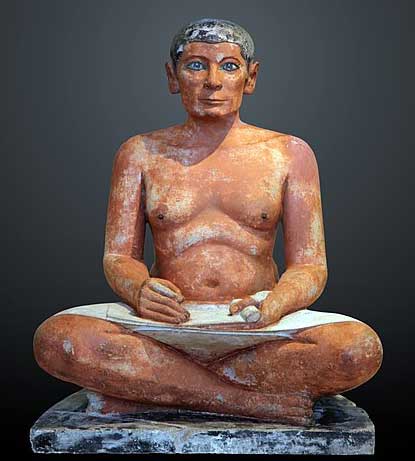Joumana Medlej's @joumajnouna "The Canticle of Creatures", a calligraphic rendering of St Francis of Assisi’s Canticle of Creatures in Arabic, in the Eastern Kufic style and materials of the Qarmatian Qur’an, written using mineral, foraged earth & plant pigments, 2021. 1/ 

Also called Laudes Creaturarum [Praise of the Creatures] or the Canticle of the Sun, Francis' work was composed around 1224 in Umbrian, his native Italian dialect. The script Joumana has used here is based on that of the Qarmatian Qur’an, made in Central Asia, circa 1180. 2/ 

"Praised be, o God, for Sister Air and the wind and clouds, and clear skies and all weathers, with which you nourish Your creatures.
Praised be, o God, for Brother Water, who is useful and humble, precious and pure." 3/
Praised be, o God, for Brother Water, who is useful and humble, precious and pure." 3/

"Praised be, o God, for Sister Fire, who illuminates the night; and she is beautiful and playful, vigorous and strong.
Praised be, o God, for our sister Mother Earth, who protects us and guides us and brings forth fruits and flowers and herbs." 4/
Praised be, o God, for our sister Mother Earth, who protects us and guides us and brings forth fruits and flowers and herbs." 4/

Joumana has used carbon ink (midād) for the rasm, and cinnabar for harakāt, verdigris for shadda and i’jām, lapis lazuli for sukūn. The borders are painted with yellow ochre she personally gathered near Tannourine in Mount Lebanon. The outer border is lapis lazuli. 5/ 

The end papers are dyed with horse chestnut husks, and painted with lac. The cover is bookcloth paper, the flap embroidered with gold thread. 6/ 

There are still a few examples available of the limited edition (15 copies) reproduction of this extraordinary artist's book, see @joumajnouna's website for more details. 7/
majnouna.com/portfolio/cant…
majnouna.com/portfolio/cant…
Here are two images of the dispersed leaves of the remarkable Qarmatian Qur'an at @metmuseum, on which @joumajnouna's calligraphy here is based. Notice the striking extreme elongation of tall letters and the ellipse formed by combining two of these letters, lam and alif. 8/ 



Of course, @joumajnouna's choice of a text by St Francis of Assisi in Arabic translation is not coincidental, it's informed by a remarkable event eight hundred years age: St. Francis of Assisi meeting with the Muslim Sultan of Palestine, Syria, and Egypt: al-Malik al-Kamil. 9/ 

As far as we know based on the historical record, this meeting - in the middle of the bloody Fifth Crusade - was the first ever meeting of its kind. Never before had two such powerful (or holy) people from their respective faiths met in a spirit of peace and understanding. 10/ 

When Francis and his companion, Illuminatus (one of his brothers with a rudimentary knowledge of Arabic), left the Christian camp for al-Kamil’s headquarters, it seemed nothing short of a suicide mission - and was perhaps intended to be just that by Francis. 11/
That they even made it to appear before the Sultan was likely because al-Kamil’s guards mistook Francis and Illuminatus for Holy Men in the same vein as Muslim sufiyya (Sufis), who wore a simple belted tunic similar to the type we still see Franciscans wearing today. 12/
Al-Malik al-Kamil was widely known as a pious and devout man. The nephew of the warlike Saladin, he received an excellent military education but was known to prefer the discipline of prayer to the sword. 13/
Al-Kamil summoned his advisers to listen as Francis spoke of the story of salvation history, its culmination in the person of Jesus Christ, and a plea in the name of God for peace between the warring factions. 14/ 

Against the advice of his advisers – who recommended killing him – he spared Francis, even inviting him to spend a week in his residence as an esteemed guest. 15/
We know nothing of the content of their conversations with the Sultan but we do know that Francis & Illuminatis left a week later, unharmed. They were gifted ample provisions for their return journey, even refusing a further offer of precious gifts - apart from one. 16/
The Christian monk accepted only one of the gifts - an ivory horn, which was used by the muezzin to call Muslims to pray. Upon returning home, Francis used this horn to call for prayer and preach among his fellow Christians. 17/
Francis was struck by the fact that Muslims prayed five times a day, and subsequently began to encourage Christians to also make prayer a regular part of their daily life. He shared with his followers his respect for Muslims that arose during his visit to al-Kamil in Egypt. 18/
Sultan al-Kamil also changed his attitude towards his Christian opponents. Reportedly if someone from the Christians was captured by his troops, he treated them with unprecedented kindness and generosity. 19/
In this way, Sultan al-Kamil (a Muslim leader with the status of a European prince) and the Christian saint Francis (with a horn for the Muslim call to prayer in his hands) became longstanding symbols of Islamic-Christian dialogue. 20/ 

And it's precisely this Islamic-Christian dialogue - more important today than ever - that @joumajnouna honors with her artistic skill and wonderful calligraphy in this Arabic translation of St Francis' "Canticle of Creatures". 21/ 







• • •
Missing some Tweet in this thread? You can try to
force a refresh


















